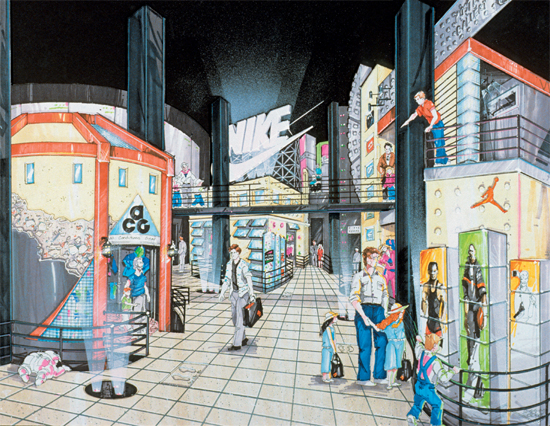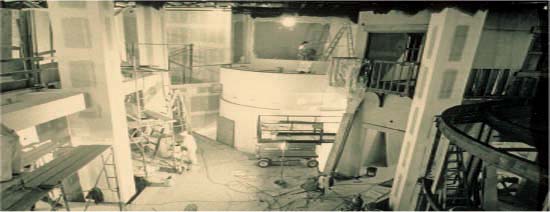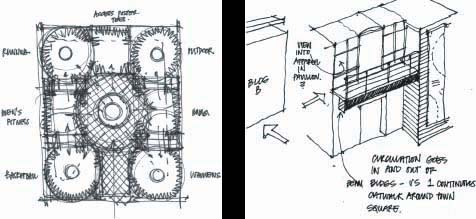WHEN I HAVE A DESIGN PROBLEM TO SOLVE, MY EYES BECOME MUCH WIDER.
I grew up in southern California, and my parents took me to Disneyland all the time. I was fascinated with the Disneyland environment. It was complete escapism, yet everything was completely designed. Of course, at the time I didn’t realize that. But something came to life there, and I loved the idea of creating a place where people went away and were entrenched in it. Even today, it’s amazing to get behind the scenes of how the park was created and how it works.
My training is unique, in that I got my undergraduate degree in architecture at the University of Southern California. Five years of architectural history gives you a good basis for referencing and conjuring up ideas. I coupled that with a graduate degree from the Art Center College of Design, in Pasadena, California, which is all about environment design, including hospitality, set, and costume design. I learned a lot about conceptual design, such as how to follow a script, concept, or strategy.
I had two weird bookends that made me look at inspiration in different ways. When I arrived at Nike, with my first project being Niketown, I was told, “We just need a store.” The strategy was something like, “We want to immerse the athlete in a great place, we want to show all the product, we want to show that we care as much about tennis as we do about running, we want to show retailers that we’re bigger than just a couple of sneakers—and we want to push the connection between athletes and the product.” Because the program kept expanding, the design needed to include an organizing principle.
When I was a sketch artist at Warner Bros., I was working on Back to the Future. The script had a street-organizing principle where it always went back to the town square. So, when I was working on Niketown, I used the organizing principle of a city or a community, but a community of sport. With this background of a controlled environment, you can take the consumer or athlete off the street and into a world that’s completely immersed in sports. That world is full of archives, merchandise, and storytelling. I think we learned a lot from the first store in how to move people through and how to sell the product within the store. At the time, this idea was pretty new. No one had really done retail theatre like this before.
Inspiration comes to me from having a problem to solve. I can’t really just walk down the street and say, “Oh, that’s inspiring.” I think more like an architect. I have to be presented with something: “We have this problem; we need you to figure out how we can solve it or make it less of a problem.”
When I have a problem to solve, my eyes become much wider. For instance, a shoe store has a lot of back stock. I knew that, of course, but I had never really thought about it. So, I didn’t really know what the back of a shoe store looked like. But with Niketown, I had a problem to solve. You have all these boxes, and somehow you have to get them to the main floor, your selling floor. Real estate is very expensive in cities, so typically you want to put your shoe storage on another floor, but how do you do that so that the customer doesn’t walk away?
Late one night, I was watching The Jetsons. I looked at the tube that George comes through from his home to his office, and I thought, that’s a really interesting idea. I’ve always loved the plastic bank deposit tubes that use air pressure to send, say, your check to some “magical place” in the bank, and then send you the cash in return. I think it’s the fantasy of it, again going back to Disneyland. Things just sort of appear, and I love that.

I wouldn’t have had the idea of delivering shoes in a tube if I had not been watching The Jetsons. It would not have crystallized in my mind that using a pneumatic tube to move product from one place to another would be iconic and unique for Nike. That’s where the shoe tube idea originated.
Inspiration is based more on a problem that needs to be solved. I start really thinking about, “What if it looked like this? What if it featured this?” I find art inspiring. I find architecture inspiring, but it becomes more real to me when there’s a problem to solve or when there’s an actual thing to apply.
For architecture, you have a program. There are so many rooms; there’s so much square footage; it has to be so tall. You have parameters to work with. Then it’s the designer’s job to take those parameters and bring them to life, and sometimes push back. I think more like a true designer where I like to show that I solved this problem. I like to prove my theories or my inspirations against something that’s happened in history. If it worked back then, the modern version of that could work as well.
The concept of not having product on the main floor really took people by surprise. It was a very different way of looking at retail. It’s almost like inverting the typical retail store where you put all the products by the door. You had to actually go through a door, and then you had to go through another door to even see a shoe.
I consciously decided that the Niketown stores should not be perfectly square. Instead, they should feature a lot of architectural randomness. They provide more of a wandering type of experience. You leave one pavilion and go to the next one. That was very World’s Fair–oriented because it’s more of an American idea to ramble where you wander and discover.
When I was at Cole Haan, we practiced the three I’s: innovation, ideation, and inspiration. How do you guide a customer through a process of education, with the final conclusion being “does the shoe work for me, does it fit, and will I buy it?”
I learned that when you give people something they didn’t expect, they like it much more. They have an affinity for newness and for rethinking something. It gave me enormous confidence in doing all of the other projects I did at Nike, because I knew that was the right road. Whether it’s innovation in a product or innovation in a store design, it gets people excited and endears them to you.
I think there are designers who give the client what they want, and they’ll be good staff designers. Design stars are the ones who lead, who really rethink the problem, apply what they learned in design school (and what they hopefully have in their DNA), and look at a problem from a different angle.
For the Niketown pavilions, there was a central circulation path through the town square, and then there was a secondary path that connected the pavilions together, so you didn’t have to always go back to the town square to move from one pavilion to the next.
Typically in department stores, cosmetics are on the first floor—you always walk through the cosmetics area before you reach your destination. I thought, what would happen if you didn’t have anything on the main floor, and everything was tucked in these pavilions, like a shopping street of sports. You interact with people on that street; you shop in these pavilions where you’re close to the product. It’s a way to separate the circulation from the actual shopping. It’s also a way to create a community, a personality, and a conversation area in the stores.





